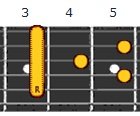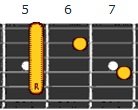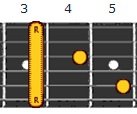The ii-V-I Jazz Progression
by btimm (Jan 25, 2011)
I am learning some jazz theory and how to play jazz guitar. I thought it may be beneficial to make a lesson for beginners regarding an introduction to jazz, specifically the most common progression in this genre of music: the ii-V-I progression. I am hopeful that this could be a form of gateway for some people to expand their horizons and learn about this phenomenal music genre! This is my first lesson though, so anyone with more knowledge please feel free to correct me if I am wrong anywhere or feel free to add anything in the comments as well!
As stated in the title of this lesson, the chords needed for this progression consist of the following chords:
[dot]the first chord in the scale, IMaj7
[dot]the second chord in the scale, iimin7
[dot]the fifth chord in the scale, V7
I am not going to go into the formation of these chords specifically and how they are made, as there is another lesson on this site that will detail this information. However, it is important to outline the notes of these chord structures to help you get started. These are given below, using C as an example.
Maj7 Chord:
1, 3, 5, 7
C, E, G, B
min7 Chord:
1, b3, 5, b7
C, Eb, G, Bb
Dominant Seventh Chord:
1, 3, 5, b7
C, E, G, Bb
As an example, the progression will be shown in the key of C. Below are the chords needed for this progression, along with a pictorial representation of one form of the chord to help get you started.
CMaj7:
1, 3, 5, 7
C, E, G, B

Dmin7:
1, b3, 5, b7
D, F, A, C
(Note that the D major scale has two sharps, so the F# and C# for this chord structure become F and C.)

G7:
1, 3, 5, b7
G, B, D, F
(Note that the G major scale has one sharp, so the F# for this chord structure become F.)

It's up to the player, but I prefer to not strike the 6th string on these chords, to give it a sound that is not as bright. It just sounds better that way to me, but it's not "wrong" to do it either way, since that note is simply repeated in the chord.
This progression is a 4-bar progression. It will consist of the Dmin7 chord for one measure, followed by a measure of the G7 chord, and finishing with two measures of the CMaj7 chord.
I feel it is important to note that this progression each chord in this progression is a fourth above the prior chord. Simply put, G is the fourth of D and C is the fourth of G.
D, E, F, G, A, B, C
The progression goes along in this manner:
I hope this lessons helps some beginners out there and introduces them to a really enjoyable form of music. I am nothing more than a beginner myself, but I thought this would be a nice way to give back to a community that has given so much to me. I will try and learn how to record myself and play this progression to be included in this lesson; however, if I cannot edit this lesson, just listen to some jazz, as most jazz songs have this progression somewhere in the song!
Getting Started: Quick Basic Chord Theory
As stated in the title of this lesson, the chords needed for this progression consist of the following chords:
[dot]the first chord in the scale, IMaj7
[dot]the second chord in the scale, iimin7
[dot]the fifth chord in the scale, V7
I am not going to go into the formation of these chords specifically and how they are made, as there is another lesson on this site that will detail this information. However, it is important to outline the notes of these chord structures to help you get started. These are given below, using C as an example.
Maj7 Chord:
1, 3, 5, 7
C, E, G, B
min7 Chord:
1, b3, 5, b7
C, Eb, G, Bb
Dominant Seventh Chord:
1, 3, 5, b7
C, E, G, Bb
Moving Along: Forming the Chords Used in This Example
As an example, the progression will be shown in the key of C. Below are the chords needed for this progression, along with a pictorial representation of one form of the chord to help get you started.
CMaj7:
1, 3, 5, 7
C, E, G, B

Dmin7:
1, b3, 5, b7
D, F, A, C
(Note that the D major scale has two sharps, so the F# and C# for this chord structure become F and C.)

G7:
1, 3, 5, b7
G, B, D, F
(Note that the G major scale has one sharp, so the F# for this chord structure become F.)

It's up to the player, but I prefer to not strike the 6th string on these chords, to give it a sound that is not as bright. It just sounds better that way to me, but it's not "wrong" to do it either way, since that note is simply repeated in the chord.
The Progression: Using the Key of C as an Example
This progression is a 4-bar progression. It will consist of the Dmin7 chord for one measure, followed by a measure of the G7 chord, and finishing with two measures of the CMaj7 chord.
I feel it is important to note that this progression each chord in this progression is a fourth above the prior chord. Simply put, G is the fourth of D and C is the fourth of G.
D, E, F, G, A, B, C
The progression goes along in this manner:
Dmin7 G7 CMaj7 CMaj7
| 1 2 3 4 | 1 2 3 4 | 1 2 3 4 | 1 2 3 4 |
Wrap Up
I hope this lessons helps some beginners out there and introduces them to a really enjoyable form of music. I am nothing more than a beginner myself, but I thought this would be a nice way to give back to a community that has given so much to me. I will try and learn how to record myself and play this progression to be included in this lesson; however, if I cannot edit this lesson, just listen to some jazz, as most jazz songs have this progression somewhere in the song!